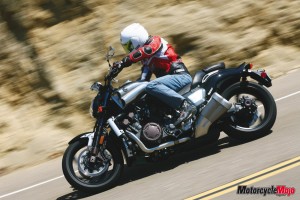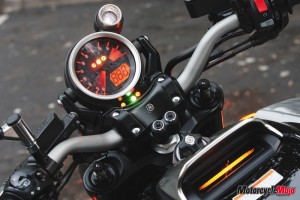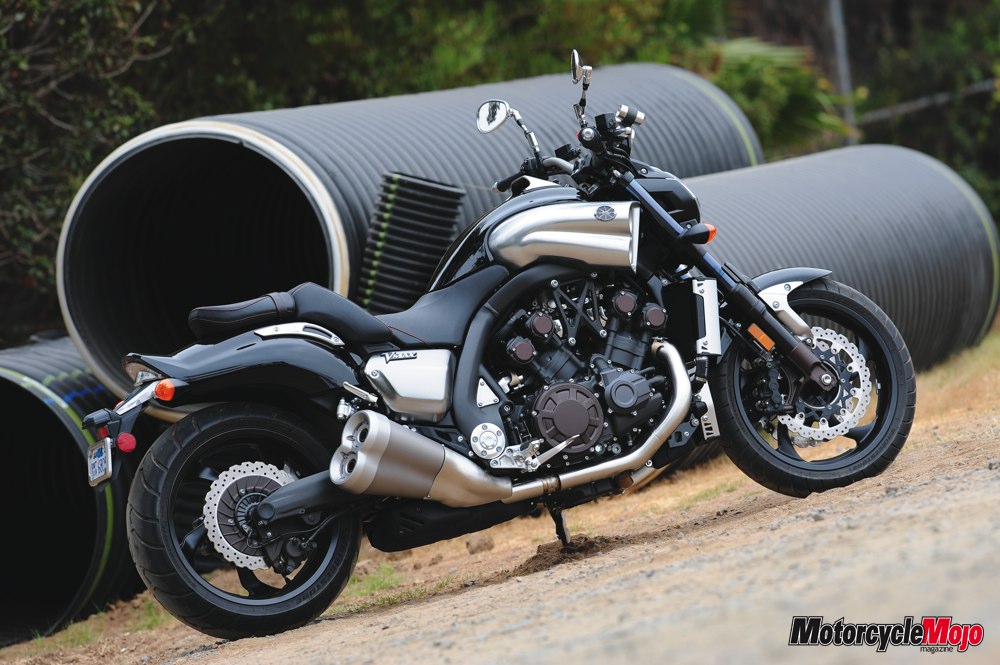 Think about the bad mistake you could make seeing an Olympic shot put contestant in casual clothes at the bar. Looking big, bulky, and decidedly un-agile, you wouldn’t think he could do too much about you cutting in front of him. In truth, he could probably rip your head off with one hand, and then throw it clear out of the bar to win a gold medal without spilling a drop of his beer. And a similar fate awaits any inexperienced sport bike rider who comes across the new ’09 VMAX, thinking they are messing with one of their Dad’s cruiser crowd. They are going to be thinking a plug lead fell off if they try challenging the new Max—with an agility that defies its size and weight, and power output to match the entire Russian weight lifting team.
Think about the bad mistake you could make seeing an Olympic shot put contestant in casual clothes at the bar. Looking big, bulky, and decidedly un-agile, you wouldn’t think he could do too much about you cutting in front of him. In truth, he could probably rip your head off with one hand, and then throw it clear out of the bar to win a gold medal without spilling a drop of his beer. And a similar fate awaits any inexperienced sport bike rider who comes across the new ’09 VMAX, thinking they are messing with one of their Dad’s cruiser crowd. They are going to be thinking a plug lead fell off if they try challenging the new Max—with an agility that defies its size and weight, and power output to match the entire Russian weight lifting team.
Let’s start with the claimed 197 horsepower from the 1679 cc V-four engine. Laying down a simply steroid induced 123 foot pounds of torque at 6,500 rpm, and host of electronic wizardry borrowed from Yamaha’s sport bike line, Mr. Max has plenty of brains to go with his brawn. Fly-by-wire throttle control, or Yamaha Chip Controlled Throttle (YCC-T) to be technically correct, connects the rider’s wrist to the 48 mm fuel-injection throttle bodies tucked in-between the new 65-degree angled cylinders. The new engine also uses YCC-I (Yamaha Chip Controlled Intake) to alter the length of the intake funnels. We first saw this on the new R1 and more recently the latest R6, and this system allows the engine to essentially tune itself at low and high rpm. Starting with a 150 mm intake funnel to help low-end torque, this has the ability to separate at 6,650 rpm. At this time a servomotor lifts the top of the funnel to leave a short, 54mm intake, perfect for achieving more top-end power. This is the first time we have seen this technology on a V-four engine, and part of the reason was to allow the new bike to have the addictive top-end hit the original machine came with. Using a system Yamaha called “V-boost,” old Max operated like a normally carbureted machine until 5700 rpm, when two carburetors then provided fuel for a single cylinder. Yanking on the throttle and experiencing the V-boost kick has stayed burned in my memory banks for over 20 years now, and I was interested to see if the new bike was capable of doing the same.
Before this opportunity arose I was able to spend a few minutes talking with the bike’s designer, Hajine Nakaaki, who told me he wanted the engine to have lots of character. An early prototype had proved too big, too powerful, and lacked this needed character. Something Mr. Nakaaki reiterated was very important for the new VMAX. Jumping on board the new machine in sunny San Diego during the press launch, it was hard to contain my excitement as we rolled out to see if he had achieved his goal.
 Before heading to California, I made a mental note to not be sucked into any crazy behavior, as I would be riding with the European journalists. With a recent press introduction getting out of control enough to land one nitwit in jail, the thought of a bunch of journalists on a two hundred horsepower motorcycle wasn’t pretty. So, leaving at the back of the pack with Hajine Nakaaki right behind me, I made sure to stick to my plan. Big respect was in order for our ride.
Before heading to California, I made a mental note to not be sucked into any crazy behavior, as I would be riding with the European journalists. With a recent press introduction getting out of control enough to land one nitwit in jail, the thought of a bunch of journalists on a two hundred horsepower motorcycle wasn’t pretty. So, leaving at the back of the pack with Hajine Nakaaki right behind me, I made sure to stick to my plan. Big respect was in order for our ride.
With traffic heavy in places, and the group meeting every overloaded truck and trailer in California, our first few miles heading east on US78 were at a mellow pace. At times I noticed the digital speedometer registering under 20 mph, and the slower we went the more I liked it. As a machine that is intended for street use, it was very impressive to see how well the new VMAX coped with the issue of slow moving traffic. Never feeling urgent or constrained, like a big, powerful dog that will stand calmly while a smaller dog goes mad barking and yapping, the VMAX rider is going to transcend the small stuff. You just know that one twist of the throttle is going to annihilate the majority of other road users, so why not sit back, be calm, and indulge in this knowledge. You just know you don’t have to try too hard.
Later, when the traffic cleared out and we had some straight pieces of road, I hung back with Mr. Nakaaki to see what it felt like to use all the power. Letting my peers gain enough distance, there was no need to signal my intentions when I slowed to walking pace before one long stretch. Twisting the throttle straight to wide open, almost induced a mild form of vertigo. I wasn’t looking far enough ahead and it all started happening too quickly. Aware of the tire screeching and laying down a long black line of smoking rubber behind, the brute force of the VMAX surging forward was just incredible. Starting strong and building all the way to the red line, there is no perceived power step, just a linear line of progressively stronger and stronger power. A drag race style shift light blinked with a big, white cross and I clutchless shifted up to second and gave it more. Topping out at 72 mph in first gear, the top end of second came quick, and I saw the VMAX passing the 120 mph mark before I throttled off. Taking a quick look behind, I could see Mr. Nakaaki, grinning through his visor, as he also slowed to keep behind me.
Seconds later, rolling along at 55 mph, looking at the beautiful, wild California hillsides, my heart was still thumping, my breath fighting to return to normal, and it felt like I was riding through a police checkpoint with a bunch of illegal substances in my veins and the Police Chief’s wife on the back. My brain was also hard at work scanning the memory banks to see if it could remember how this experience compares to the ZX14 or the new Busa. While the rush is similar, the sheer muscular presence of the VMAX seemed to make the experience more intense.
Tipping into some corners, the bike’s 658-pound dry weight is nicely disguised, until you go past a sporting pace. At sensible speeds and a little more, the sportbike style aluminum frame, gargantuan conventional forks, and multi-adjustable rear shock keep both wheels going in the right direction. Get passed the comfort zone and things start getting hairy. Over 800 pounds of man and machine bouncing in a sideways motion towards the edge of the road make not for a pretty sight, or clean underwear. Checking closely on the suspension specs, the front forks are Soqi 52 mm units, with a mixture of cast aluminum top triple clamp, lower fork legs, and a forged aluminum lower triple clamp with extruded aluminum legs. With titanium oxide coated tubes, they offer 4.7 inches of travel, and are adjustable for preload, compression, and rebound damping.
 In the rear, Soqi also takes care of shock duties, while offering a remote adjuster to set your desired preload, compression or rebound damping settings. With 4.3 inches of travel, the VMAX offers a very compliant ride over the majority of surfaces, while a butch looking cast aluminum swingarm houses the rear wheel and the shaft drive system. This is a solid, 5-spoke, 18-inch aluminum hoop that comes wrapped in a 200/50 18-inch Bridgestone rear tire. While not over the top compared to some cruisers, the tire is still big enough to give the VMAX the sensation it pivots around the rear tire at times. Not annoying, just evident enough to let you know there’s a big tire back there. At the other end, a similarly styled 18-inch front wheel gets a 120/70 R18 front Bridgestone, which I am assuming had to be made for the VMAX like the rear is, as I’m not sure of another bike using this sizing.
In the rear, Soqi also takes care of shock duties, while offering a remote adjuster to set your desired preload, compression or rebound damping settings. With 4.3 inches of travel, the VMAX offers a very compliant ride over the majority of surfaces, while a butch looking cast aluminum swingarm houses the rear wheel and the shaft drive system. This is a solid, 5-spoke, 18-inch aluminum hoop that comes wrapped in a 200/50 18-inch Bridgestone rear tire. While not over the top compared to some cruisers, the tire is still big enough to give the VMAX the sensation it pivots around the rear tire at times. Not annoying, just evident enough to let you know there’s a big tire back there. At the other end, a similarly styled 18-inch front wheel gets a 120/70 R18 front Bridgestone, which I am assuming had to be made for the VMAX like the rear is, as I’m not sure of another bike using this sizing.
What goes forward at high speed must stop very quickly, so for this job the VMAX is equipped with a pair of six piston Sumitomo brake calipers at the pointy end. Working in conjunction with a pair of 320 mm wave rotors, they receive their correct ration of brake fluid to push the pads from a Brembo radial pump master cylinder. And, to ensure you don’t over do it, the VMAX also has Anti-Lock Brakes. When put to the test, they do an admirable job of bringing the beast under control when you consider the job they have to do with a bike of this size. Squeezing the lever hard enough to activate this system, I was surprised to be greeted with a fairly long screeching sound as the front tire locked before the system let it go. It was the same with the rear. While not enough to cause any real worry, it just seemed longer than some systems I have tested and took some mental reprogramming to ignore the sound.
Ergonomics wise, the new 2009 VMAX sits you up straight with an aggressive stance and arms out straight to the bars. With a 31-inch inseam, I am on the balls of my feet at traffic lights. This is due to the wide seat, but with the comfortable wide bars the combination was not unsettling for me. With a 66.9-inch wheelbase, four inches longer than the original V-Max, you have to do some careful navigating when in town. It also takes a good wide road to make a clean turn. The clutch and the throttle are so light and in-sync that none of this is a headache. Just be aware you aren’t going to be whipping any quick U-turns in tight spaces.
No conversation about the new VMAX is going to take place without mention of the styling. Personally, I think Yamaha has hit the ball out of the park. It is just where the old V-Max needed to go, and is the perfect balance between then and now. If I have one area of complaint it would be the headlight, as I’m not sure about it’s look, but everything else is brilliant. The similar looking scoops on the side of the new Max are actually a functional part of the air intake this time around and look the business. There are also some even cooler carbon fibre accessory scoops available through Yamaha if you so desire.
And no conversation about the styling is going to be complete without mention of the exhaust system. Looking as if the VMAX is hanging a couple of Vespas either side of its muscular spine, the 4-into-1-into-2-into-4 system actually hides a catalytic converter and an EXUP valve. Giving the engine a deep muted growl, Mr. Nakaaki told me a performance system will be available soon for those who want more noise. I can’t imagine anyone needing more power?
While there are a multitude of interesting features, exotic parts, and styling details to be found on the new VMAX, I have to talk briefly about the innovative instrument set up. With the big, aggressive looking tachometer, equipped with an outrigger shift light and internal digital speedometer, there is also a tank mounted digital display panel. This performs a multitude of functions from greeting the rider when the key is turned on, to giving all the in-flight information you will ever need on the road: Fuel, miles, time, gear position, coolant temperature, air-temp and more.
Priced at $21,999, to purchase a new VMAX you will have to put a deposit of $1000 down at your local dealer and get in line if you want one. With limited numbers being produced to keep interest high and to assure the bike’s longevity, it might be better to do this sooner rather than later since there are only about 250 coming to Canada. In a world of increasing regulations and all the other changes we are facing economically, motorcycle manu-facturers might be thinking twice about trying to build anything that can eclipse the VMAX for sheer brute horsepower and physical presence. So this might be the last chance to own the most powerful, outrageous production motorcycle ever built. MMM



















